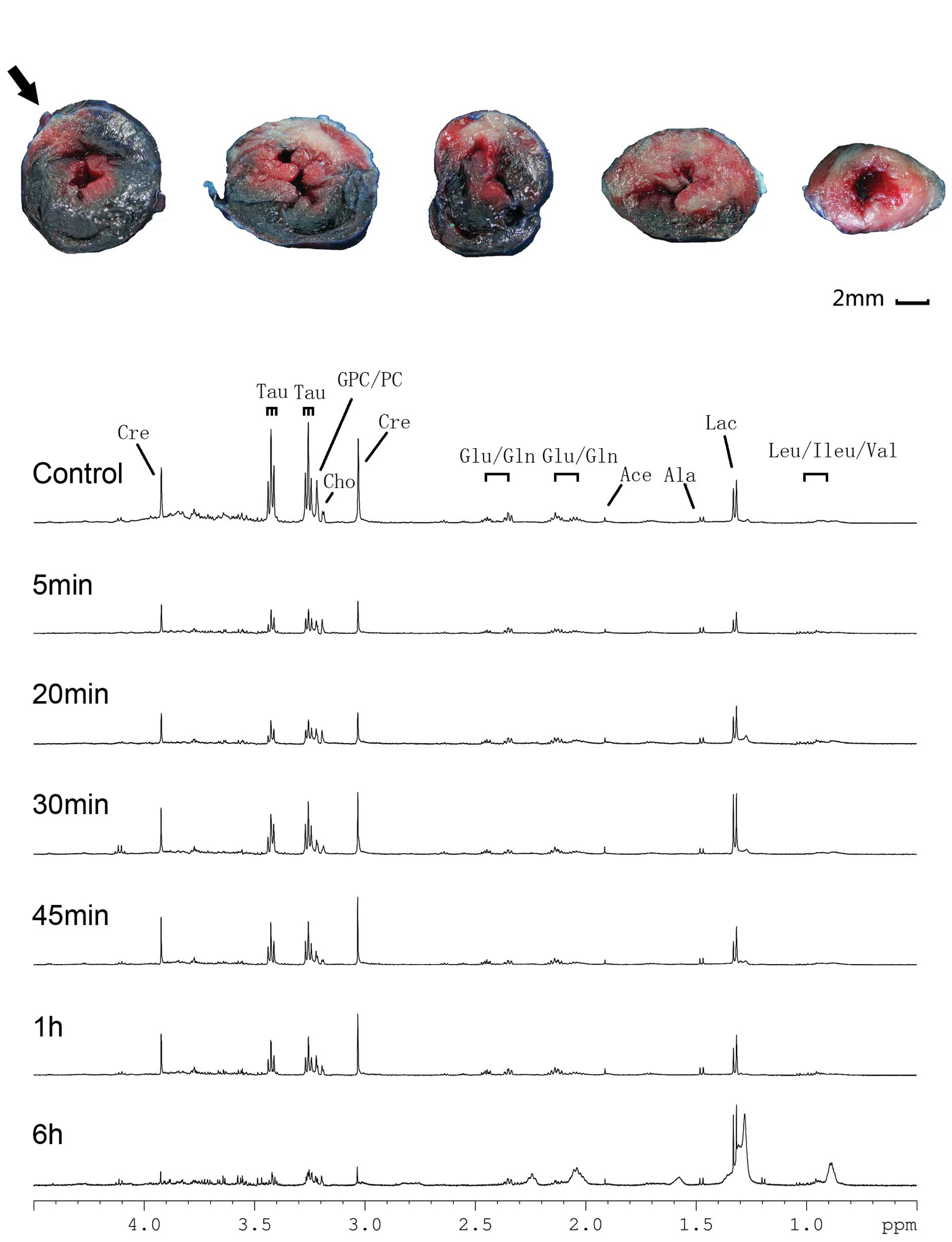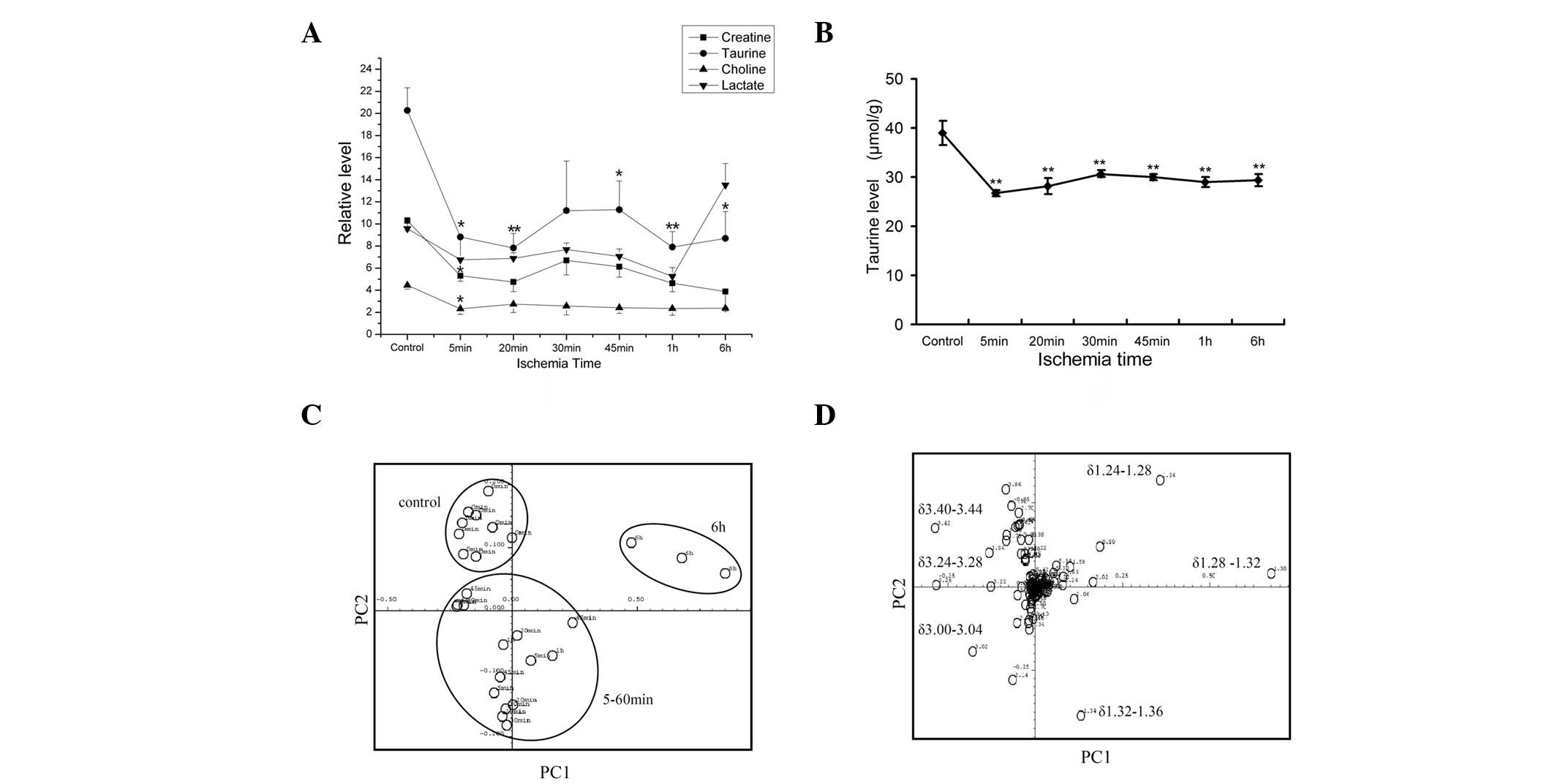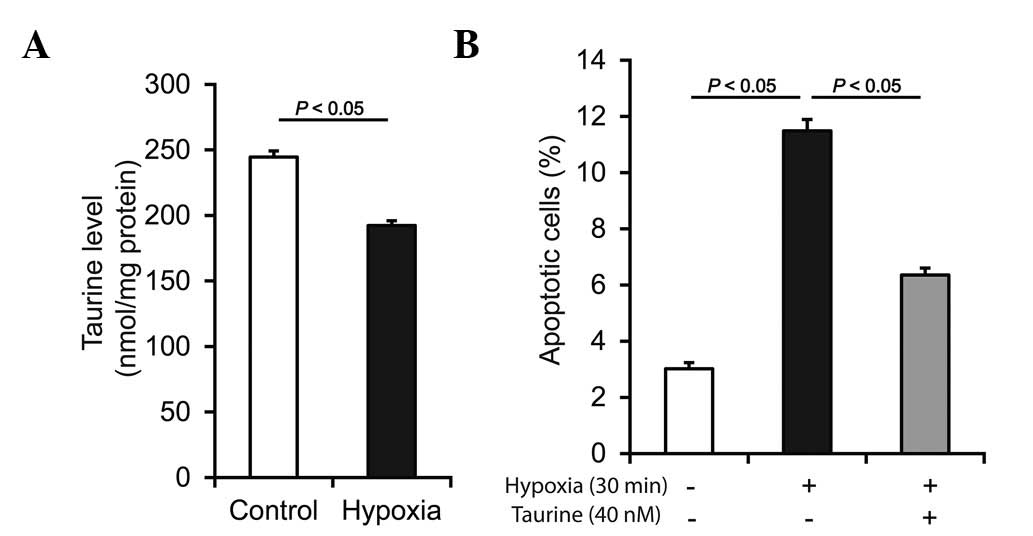|
1.
|
Thom T, Haase N, Rosamond W, et al: Heart
disease and stroke statistics - 2006 update: a report from the
American Heart Association Statistics Committee and Stroke
Statistics Subcommittee. Circulation. 113:e85–e151. 2006.
View Article : Google Scholar : PubMed/NCBI
|
|
2.
|
Ilva T, Lassus J, Siirilä-Waris K, et al:
Clinical significance of cardiac troponins I and T in acute heart
failure. Eur J Heart Fail. 10:772–779. 2008. View Article : Google Scholar : PubMed/NCBI
|
|
3.
|
Bottomley PA and Weiss RG: Non-invasive
magnetic-resonance detection of creatine depletion in non-viable
infarcted myocardium. Lancet. 351:714–718. 1998. View Article : Google Scholar : PubMed/NCBI
|
|
4.
|
Friess U and Stark M: Cardiac markers: a
clear cause for point-of-care testing. Anal Bioanal Chem.
393:1453–1462. 2009. View Article : Google Scholar : PubMed/NCBI
|
|
5.
|
Barba I, Jaimez-Auguets E,
Rodriguez-Sinovas A and Garcia-Dorado D: 1H NMR-based
metabolomic identification of at-risk areas after myocardial
infarction in swine. MAGMA. 20:265–271. 2007. View Article : Google Scholar
|
|
6.
|
Beer M, Buchner S, Sandstede J, et al:
(31)P-MR Spectroscopy for the evaluation of energy metabolism in
intact residual myocardium after acute myocardial infarction in
humans. MAGMA. 13:70–75. 2001. View Article : Google Scholar : PubMed/NCBI
|
|
7.
|
Cousins JP: Clinical MR spectroscopy:
fundamentals, current applications, and future potential. AJR Am J
Roentgenol. 164:1337–1347. 1995. View Article : Google Scholar : PubMed/NCBI
|
|
8.
|
Walecki J, Michalak MJ, Michalak E and
Pasowicz M: Use of magnetic resonance spectroscopy in cardiology.
State of the art. Przegl Lek. 59:601–605. 2002.(In Polish).
|
|
9.
|
Horn M: Cardiac magnetic resonance
spectroscopy: a window for studying physiology. Methods Mol Med.
124:225–248. 2006.PubMed/NCBI
|
|
10.
|
Hudsmith LE and Neubauer S: Magnetic
resonance spectroscopy in myocardial disease. JACC Cardiovasc
Imaging. 2:87–96. 2009. View Article : Google Scholar : PubMed/NCBI
|
|
11.
|
Caus T, Kober F, Mouly-Bandini A, et al:
31P MRS of heart grafts provides metabolic markers of
early dysfunction. Eur J Cardiothorac Surg. 28:576–580. 2005.
View Article : Google Scholar
|
|
12.
|
Beer M, Seyfarth T, Sandstede J, et al:
Absolute concentrations of high-energy phosphate metabolites in
normal, hypertrophied, and failing human myocardium measured
noninvasively with 31P-SLOOP magnetic resonance spectroscopy. J Am
Coll Cardiol. 40:1267–1274. 2002. View Article : Google Scholar
|
|
13.
|
Holloway C, ten Hove M, Clarke K and
Neubauer S: MR spectroscopy in heart failure. Front Biosci (Schol
Ed). 3:331–340. 2011. View
Article : Google Scholar : PubMed/NCBI
|
|
14.
|
Garrod S, Humpfer E, Spraul M, et al:
High-resolution magic angle spinning 1H NMR
spectroscopic studies on intact rat renal cortex and medulla. Magn
Reson Med. 41:1108–1118. 1999. View Article : Google Scholar : PubMed/NCBI
|
|
15.
|
Perrine SA, Michaels MS, Ghoddoussi F,
Hyde EM, Tancer ME and Galloway MP: Cardiac effects of MDMA on the
metabolic profile, determined with 1H-magnetic resonance
spectroscopy in the rat. NMR Biomed. 22:419–425. 2009. View Article : Google Scholar : PubMed/NCBI
|
|
16.
|
Bollard ME, Murray AJ, Clarke K, Nicholson
JK and Griffin JL: A study of metabolic compartmentation in the rat
heart and cardiac mitochondria using high-resolution magic angle
spinning 1H NMR spectroscopy. FEBS Lett. 553:73–78.
2003. View Article : Google Scholar : PubMed/NCBI
|
|
17.
|
Griffin JL, Sang E, Evens T, Davies K and
Clarke K: Metabolic profiles of dystrophin and utrophin expression
in mouse models of Duchenne muscular dystrophy. FEBS Lett.
530:109–116. 2002. View Article : Google Scholar : PubMed/NCBI
|
|
18.
|
Jones GL, Sang E, Goddard C, et al: A
functional analysis of mouse models of cardiac disease through
metabolic profiling. J Biol Chem. 280:7530–7539. 2005. View Article : Google Scholar : PubMed/NCBI
|
|
19.
|
Barba I, de León G, Martin E, et al:
Nuclear magnetic resonance-based metabolomics predicts
exercise-induced ischemia in patients with suspected coronary
artery disease. Magn Reson Med. 60:27–32. 2008. View Article : Google Scholar
|
|
20.
|
Gupta RC, Win T and Bittner S: Taurine
analogues; a new class of therapeutics: retrospect and prospects.
Curr Med Chem. 12:2021–2039. 2005. View Article : Google Scholar : PubMed/NCBI
|
|
21.
|
Ueno T, Iguro Y, Yotsumoto G, et al:
Taurine at early reperfusion significantly reduces myocardial
damage and preserves cardiac function in the isolated rat heart.
Resuscitation. 73:287–295. 2007. View Article : Google Scholar : PubMed/NCBI
|
|
22.
|
Oriyanhan W, Yamazaki K, Miwa S, Takaba K,
Ikeda T and Komeda M: Taurine prevents myocardial
ischemia/reperfusion-induced oxidative stress and apoptosis in
prolonged hypothermic rat heart preservation. Heart Vessels.
20:278–285. 2005. View Article : Google Scholar
|
|
23.
|
Hayes KC and Sturman JA: Taurine in
metabolism. Annu Rev Nutr. 1:401–425. 1981. View Article : Google Scholar : PubMed/NCBI
|
|
24.
|
Warskulat U, Flögel U, Jacoby C, et al:
Taurine transporter knockout depletes muscle taurine levels and
results in severe skeletal muscle impairment but leaves cardiac
function uncompromised. FASEB J. 18:577–579. 2004.
|
|
25.
|
Heller-Stilb B, van Roeyen C, Rascher K,
et al: Disruption of the taurine transporter gene (taut) leads to
retinal degeneration in mice. FASEB J. 16:231–233. 2002.PubMed/NCBI
|
|
26.
|
Liu X, Gu X, Li Z, et al:
Neuregulin-1/erbB-activation improves cardiac function and survival
in models of ischemic, dilated, and viral cardiomyopathy. J Am Coll
Cardiol. 48:1438–1447. 2006. View Article : Google Scholar : PubMed/NCBI
|
|
27.
|
Garcia-Dorado D, González MA, Barrabés JA,
et al: Prevention of ischemic rigor contracture during coronary
occlusion by inhibition of Na+-H+ exchange.
Cardiovasc Res. 35:80–89. 1997. View Article : Google Scholar : PubMed/NCBI
|
|
28.
|
Griffin JL, Mann CJ, Scott J, Shoulders CC
and Nicholson JK: Choline containing metabolites during cell
transfection: an insight into magnetic resonance spectroscopy
detectable changes. FEBS Lett. 509:263–266. 2001. View Article : Google Scholar
|
|
29.
|
Holmes E, Nicholls AW, Lindon JC, et al:
Chemometric models for toxicity classification based on NMR spectra
of biofluids. Chem Res Toxicol. 13:471–478. 2000. View Article : Google Scholar : PubMed/NCBI
|
|
30.
|
Lindon JC, Holmes E and Nicholson JK:
Pattern recognition methods and applications in biomedical magnetic
resonance. Prog Nucl Magn Reson Spectrosc. 39:1–40. 2001.
View Article : Google Scholar
|
|
31.
|
Rowley HL, Martin KF and Marsden CA:
Determination of in vivo amino acid neurotransmitters by
high-performance liquid chromatography with
o-phthalaldehyde-sulphite derivatisation. J Neurosci Methods.
57:93–99. 1995. View Article : Google Scholar : PubMed/NCBI
|
|
32.
|
Zhu W, Chen J, Cong X, Hu S and Chen X:
Hypoxia and serum deprivation-induced apoptosis in mesenchymal stem
cells. Stem Cells. 24:416–425. 2006. View Article : Google Scholar : PubMed/NCBI
|
|
33.
|
Wang TJ: Significance of circulating
troponins in heart failure: if these walls could talk. Circulation.
116:1217–1220. 2007. View Article : Google Scholar : PubMed/NCBI
|
|
34.
|
Collinson PO, Boa FG and Gaze DC:
Measurement of cardiac troponins. Ann Clin Biochem. 38:423–449.
2001. View Article : Google Scholar : PubMed/NCBI
|
|
35.
|
Chan CP, Sanderson JE, Glatz JF, Cheng WS,
Hempel A and Renneberg R: A superior early myocardial infarction
marker. Human heart-type fatty acid-binding protein. Z Kardiol.
93:388–397. 2004. View Article : Google Scholar : PubMed/NCBI
|
|
36.
|
Seino Y, Tomita Y, Takano T and Ohbayashi
K; Tokyo Rapid-Test Office Cardiologists (Tokyo-ROC) Study: Office
cardiologists cooperative study on whole blood rapid panel tests in
patients with suspicious acute myocardial infarction: comparison
between heart-type fatty acid-binding protein and troponin T tests.
Circ J. 68:144–148. 2004. View Article : Google Scholar
|
|
37.
|
Schaefer S, Schwartz GG, Gober JR, et al:
Relationship between myocardial metabolites and contractile
abnormalities during graded regional ischemia. Phosphorus-31
nuclear magnetic resonance studies of porcine myocardium in vivo. J
Clin Invest. 85:706–713. 1990. View Article : Google Scholar
|
|
38.
|
Shen W, Asai K, Uechi M, et al:
Progressive loss of myocardial ATP due to a loss of total purines
during the development of heart failure in dogs: a compensatory
role for the parallel loss of creatine. Circulation. 100:2113–2118.
1999. View Article : Google Scholar : PubMed/NCBI
|
|
39.
|
Van de Werf F, Bax J, Betriu A, et al:
Management of acute myocardial infarction in patients presenting
with persistent ST-segment elevation: the Task Force on the
Management of ST-Segment Elevation Acute Myocardial Infarction of
the European Society of Cardiology. Eur Heart J. 29:2909–2945.
2008.
|
|
40.
|
Mahrholdt H, Klem I and Sechtem U:
Cardiovascular MRI for detection of myocardial viability and
ischaemia. Heart. 93:122–129. 2007. View Article : Google Scholar : PubMed/NCBI
|












